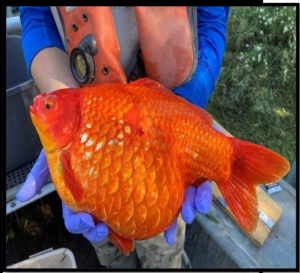THE GOLDFISH INVASION: THREATS IN OPEN WATERS
The seemingly innocuous goldfish, popular as a pet in fishbowls, becomes a colossal threat when introduced into open water bodies.
Source: NYT
Characteristics and Threats:
- Goldfish, native to East Asia, often kept as aesthetic pets, grow into a giant menace when released into lakes and rivers.
- Originally bred for aesthetic pleasure and good fortune, they transform into invasive species in the wild.
Environmental Impact:
- Invasive goldfish pose a significant environmental threat, particularly in areas like Hamilton Harbour on Lake Ontario, decimated by industrial development and invasive species.
- Fast growth, quick reproduction, and adaptability make them destructive to native marine life and ecosystems.
Destructive Behaviour:
- Goldfish’s ability to consume anything, including algae, aquatic plants, eggs, and invertebrates, leads to harmful algal blooms.
- Their football-shaped bodies can grow up to 16 inches, making them immune to predation and disrupting the balance of the ecosystem.
Research Findings:
- Recent research by Fisheries and Oceans Canada in Hamilton Harbour helps identify goldfish populations for targeted control measures.
- Early detection of their locations before spawning enables more effective culling strategies.
- Female goldfish can reproduce multiple times in one season, exacerbating their population growth.
- Goldfish’s adaptability to a variety of water temperatures and conditions, combined with climate change, contributes to their proliferation.
Global Impact:
- The goldfish invasion extends beyond Canada, with instances reported in Australia, the United Kingdom, and the United States, emphasizing its global impact.
- Unwanted pet releases in urban ponds contribute to the escalating problem.
The once-beloved pet, when released into open waters, becomes an environmental menace, demanding proactive measures to control and mitigate its widespread impact on ecosystems globally.

 Source: NYT
Source: NYT

